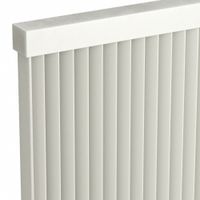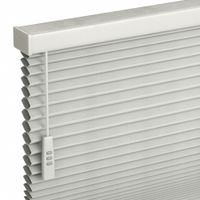Call +(254) 703 030 000 / 751 483 999 / 721 704 777
- Home
- Furnishings Appliances Hospitality
- Furnishings Building Supplies
- Window Treatments
Frequently Asked Questions
What are the best window treatments for insulation?
The best window treatments for insulation are those that effectively reduce heat loss in winter and minimize heat gain in summer. Here are some top options:
1. **Cellular Shades (Honeycomb Shades):** These are highly effective for insulation due to their unique honeycomb structure, which traps air in pockets, creating a barrier between the window and the room. They come in single, double, or triple cell designs, with more cells offering better insulation.
2. **Thermal Curtains:** Made from thick, heavy materials, often with a thermal lining, these curtains help block drafts and retain heat. They are particularly effective when they extend beyond the window frame and reach the floor.
3. **Insulated Roman Shades:** These shades combine the elegance of Roman shades with added insulation. They often have a thermal backing that helps reduce heat transfer.
4. **Shutters:** Interior shutters, especially those made from solid wood or composite materials, provide a good barrier against heat loss. They fit tightly within the window frame, reducing drafts.
5. **Window Quilts:** These are fabric panels that roll down over the window, similar to a quilt. They are highly effective at trapping air and providing insulation.
6. **Dual Roller Shades:** These shades offer a combination of a blackout shade for insulation and a sheer shade for light control, allowing flexibility in managing heat and light.
7. **Drapes with Thermal Liners:** Adding a thermal liner to existing drapes can significantly improve their insulating properties. The liner acts as an additional barrier to heat transfer.
For optimal insulation, it's important to ensure that window treatments are properly fitted and cover the entire window area. Combining different treatments, such as using cellular shades with thermal curtains, can enhance insulation further.
How do blinds help in reducing energy costs?
Blinds help reduce energy costs by providing insulation, controlling sunlight, and enhancing energy efficiency. During hot weather, blinds can block direct sunlight, reducing heat gain and lowering the need for air conditioning. By reflecting sunlight away, they keep indoor temperatures cooler, which decreases the reliance on cooling systems and thus reduces energy consumption.
In colder months, blinds act as an insulating barrier. When closed, they trap a layer of air between the window and the room, minimizing heat loss. This insulation effect helps maintain indoor warmth, reducing the need for heating and consequently lowering energy bills.
Blinds also offer flexibility in light control. By adjusting the slats, occupants can manage the amount of natural light entering a room, reducing the need for artificial lighting during the day. This not only saves on electricity costs but also maximizes the use of daylight, which can have positive effects on mood and productivity.
Moreover, some blinds are designed with energy-efficient materials, such as reflective coatings or cellular structures, which enhance their insulating properties. These specialized blinds can further improve energy savings by optimizing thermal performance.
Automated or smart blinds can be programmed to adjust based on the time of day or temperature, ensuring optimal energy efficiency without manual intervention. This automation can lead to more consistent energy savings by adapting to changing environmental conditions.
Overall, by effectively managing heat gain and loss, controlling light, and utilizing advanced materials and technologies, blinds contribute significantly to reducing energy costs in both residential and commercial settings.
What types of window shades are most effective for blocking light?
The most effective window shades for blocking light are blackout shades, cellular shades, roller shades, Roman shades, and dual shades.
1. **Blackout Shades**: These are specifically designed to block out nearly all incoming light. Made from opaque materials, they are ideal for bedrooms or media rooms where complete darkness is desired. They often come with side tracks to prevent light leakage around the edges.
2. **Cellular Shades**: Also known as honeycomb shades, these are effective at blocking light due to their unique structure. The cells trap air, providing insulation and reducing light penetration. For maximum light blocking, opt for double or triple-cell designs with blackout fabric.
3. **Roller Shades**: These shades are made from a single piece of fabric that rolls up and down. Blackout roller shades use thick, opaque materials to prevent light from passing through. They can be fitted with side channels to minimize light gaps.
4. **Roman Shades**: These fabric shades fold neatly when raised and can be lined with blackout material to enhance their light-blocking capabilities. They offer a stylish option while effectively darkening a room.
5. **Dual Shades**: These combine two layers of fabric, typically a sheer and a blackout layer, allowing for flexible light control. The blackout layer can be adjusted to completely block light when needed.
For optimal light blocking, consider shades with side tracks or channels to eliminate gaps where light can seep through. Additionally, choosing darker colors and thicker materials can enhance the light-blocking effectiveness of any shade type.
Can window treatments really lower my energy bills?
Yes, window treatments can significantly lower your energy bills. They act as insulators, reducing heat loss in the winter and minimizing heat gain in the summer. By controlling the amount of sunlight and heat that enters or escapes your home, window treatments help maintain a consistent indoor temperature, reducing the need for heating and cooling.
In the winter, insulated curtains or thermal drapes can prevent heat from escaping through windows, keeping rooms warmer and reducing the need for heating. Cellular shades, also known as honeycomb shades, are particularly effective due to their unique structure that traps air and provides an additional layer of insulation.
During the summer, reflective blinds or shades can block and reflect sunlight, keeping interiors cooler and reducing the reliance on air conditioning. Solar shades are designed to reduce glare and heat while maintaining visibility, making them ideal for sunny climates.
Automated or smart window treatments can further enhance energy efficiency by adjusting based on the time of day or temperature, optimizing natural light and heat management without manual intervention.
Additionally, window films can be applied directly to glass to reduce heat gain and UV exposure, offering a cost-effective solution for energy savings.
Overall, by choosing the right window treatments and using them effectively, you can reduce energy consumption, lower utility bills, and create a more comfortable living environment.
How do I choose between blinds and shades for energy efficiency?
To choose between blinds and shades for energy efficiency, consider the following factors:
1. **Material and Insulation**: Shades generally offer better insulation than blinds. Cellular shades, also known as honeycomb shades, are particularly effective due to their design, which traps air in pockets, providing excellent insulation. Blinds, especially those made of wood or faux wood, can also offer some insulation but are less effective than cellular shades.
2. **Light Control and Heat Gain**: Blinds allow for adjustable light control, which can help manage heat gain. You can tilt the slats to reflect sunlight away while still allowing some light in. Shades, especially those with reflective backing, can block more sunlight and reduce heat gain, but they offer less flexibility in light control.
3. **Seasonal Considerations**: In colder months, cellular shades are superior for retaining heat. In warmer months, both blinds and shades can reduce cooling costs, but shades with reflective coatings are more effective at blocking heat.
4. **Window Orientation**: For windows that receive direct sunlight, shades with reflective or blackout properties are more energy-efficient. For less exposed windows, blinds might suffice.
5. **Cost and Aesthetics**: Blinds are generally less expensive and offer a variety of styles and finishes. Shades, particularly energy-efficient ones, can be more costly but may offer long-term savings on energy bills.
6. **Ease of Use and Maintenance**: Blinds are easier to clean and maintain, while shades may require more care. Consider motorized options for ease of use, especially for hard-to-reach windows.
Ultimately, for maximum energy efficiency, cellular shades are often the best choice, but the decision should also consider your specific needs, budget, and aesthetic preferences.
What materials are best for insulating window treatments?
The best materials for insulating window treatments include:
1. **Cellular Shades (Honeycomb Shades):** These are highly effective due to their unique structure, which traps air in their cells, providing excellent insulation. The more layers or cells, the better the insulation.
2. **Thermal Curtains/Drapes:** Made from thick, dense fabrics like velvet, wool, or polyester blends, these curtains often have a thermal lining that helps block drafts and retain heat.
3. **Insulated Roman Shades:** These shades combine the elegance of Roman shades with thermal backing, often made from materials like foam or fleece, to enhance insulation.
4. **Window Quilts:** These are similar to comforters for windows, consisting of multiple layers of fabric and batting that can be rolled up or down, providing a snug fit to prevent air leaks.
5. **Shutters:** Interior shutters, especially those made from solid wood or composite materials, can provide a barrier against heat loss and gain.
6. **Double or Triple Layered Curtains:** Using multiple layers of fabric, such as a combination of sheer and heavy drapes, can create an insulating air pocket between the layers.
7. **Reflective Films:** Applied directly to the window glass, these films reflect heat back into the room during winter and block solar heat in the summer.
8. **Magnetic or Velcro Seals:** Adding magnetic or Velcro strips to the edges of window treatments can help create a tighter seal, reducing drafts.
9. **Foam-Backed Blinds:** These blinds have a foam layer that enhances their insulating properties, making them effective at reducing heat transfer.
10. **Blackout Curtains:** While primarily used for blocking light, their thick fabric also provides some level of insulation.
Choosing the right material depends on the specific needs, climate, and aesthetic preferences.
Are there specific brands known for energy-efficient window treatments?
Yes, several brands are known for their energy-efficient window treatments. Hunter Douglas is renowned for its Duette® Honeycomb Shades, which are designed to trap air and create an insulating barrier at the window. This helps in reducing energy consumption by keeping homes warmer in winter and cooler in summer.
Lutron offers Serena® Smart Shades, which can be programmed to adjust automatically based on the time of day or sunlight, optimizing energy efficiency by reducing the need for heating and cooling.
Levolor is another brand that provides energy-efficient options, particularly with their cellular shades that offer excellent insulation properties.
Bali Blinds also offers a range of cellular shades known for their energy-saving capabilities, helping to maintain a consistent indoor temperature.
Graber is recognized for its CrystalPleat® Cellular Shades, which are designed to provide superior insulation and energy efficiency.
Comfortex offers the ComforTrack Plus Energy Saving Sidetrack System, which enhances the energy efficiency of their cellular shades by reducing heat loss and gain.
These brands focus on innovative designs and materials that enhance insulation, reduce energy costs, and contribute to a more sustainable living environment.

